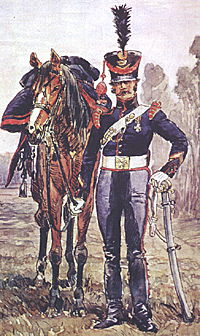Netherlands Artillery
in the Waterloo Campaign
Part I: The Artillery
in the Southern Netherlands
by Geert van Uythoven, The Netherlands
| |
Sergeant, horse artillery, in full dress. The territory earmarked for this increase were the Austrian Netherlands, and on 1 August 1814 the Prince of Orange accepted government of the Southern Netherlands as gouverneur-generaal, until the Allied powers would have taken a final decision. For the time being the ‘southern army’ would remain separate from that of the north. Already before this date, part of the army of the Northern Netherlands
commanded by Prince Frederick of Orange, including three companies of foot artillery, commanded by the Captains J. Gallas, P. Wijnands, and J.H.G. Scheffer 3 ,
had moved to the south as some kind of future occupation army. Initially, this army stayed in the Northern Netherlands, with the 1st Brigade (Cornabé) at ‘s Hertogenbosch and surroundings; the 2nd
Brigade (Perponcher) at Bergen-op-Zoom; and the 3rd Brigade (Stedman) at Maastricht. Mobilising the three batteries was difficult, mainly due to the lack of horse teams. On 20 January 1815, only two batteries were present; the Horse artillery battery ‘Petter’ at Maastricht which replaced the first two foot batteries; and Foot artillery battery ‘Scheffer’ (4th company, 1st Line artillery battalion) at Namur. Later another Horse artillery batterie arrived, commanded by Captain A. Bijleveld, while the Foot artillery battery ‘Scheffer’ was relieved by the Foot artillery battery ‘Wijnands’ on 20 May 1815, which at this time was able to take the field properly. 4
After the French had been pushed back out of the Southern Netherlands, mainly through the efforts of the Prussian and British forces, a number of units were raised, including a battalion ion of foot artillery in the city of Mechelen. On 18 August it was decided, effective 1 September 1814, that the southern artillery would consist of a battalion of foot artillery and two horse artillery companies. Still separate from the north though, on 7 September it was decreed that the artillery would receive the same organisation as that of the northern army. Already before these dates, on 14 August Lieutenant-Colonel M.A. Kuytenbrouwer was ordered to the Southern Netherlands, to raise two foot artillery companies, and two horse artillery companies in Mechelen.
On 24 March 1815, before the army of the Southern Netherlands was merged with that of the Northern Netherlands, the artillery had reached the following strength [officers/others]:
One has to note however that the numbers say nothing about the readiness of the artillery: the availability of material, equipment and horses was even worse in the northern Netherlands! Captain C.F. Krahmer de Bichin was busy forming a horse artillery battery, as was Captain E.J. Stevenart with forming a foot artillery battery.
Netherlands Artillery in the Waterloo Campaign 1815 Part I
Netherlands Artillery in the Waterloo Campaign 1815 Part II: Artillery Officers
|
 Initially, after the truce of 21 April 1814, the former Austrian Netherlands came back under Austrian rule. This did not last long; the 6th article of the Treaty of Paris (30 May 1814) stipulated that ‘Holland, under sovereignty of the House of Orange, would receive an increase of territory’, to form a strong bastion in the north against possible French aggression in the future.
Initially, after the truce of 21 April 1814, the former Austrian Netherlands came back under Austrian rule. This did not last long; the 6th article of the Treaty of Paris (30 May 1814) stipulated that ‘Holland, under sovereignty of the House of Orange, would receive an increase of territory’, to form a strong bastion in the north against possible French aggression in the future.